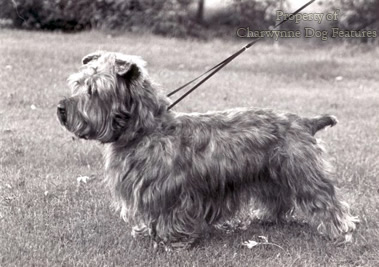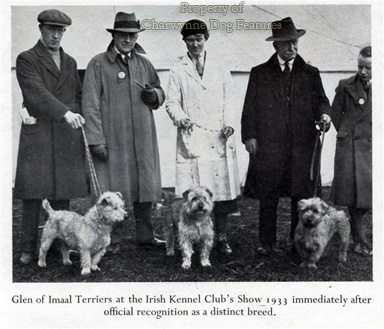747 WELCOMING THE GLEN
WELCOMING THE GLEN
by David Hancock
This game little breed of terrier from Ireland, despite its ancient existence, was only recognised as a breed by the Irish Kennel Club in 1933 and then subsequently by the Kennel Club in England and listed as a rare breed of dog. From a mere 9 in 1979 and 16 in 2001, registrations here rose to 89 by 2008, a sure sign of their growing popularity. Small but substantial, weighing 35lbs and measuring 14 inches at the withers, the breed has a harsh outer coat between 3 and 4 inches in length and a shorter softer undercoat. Usually blue brindle or wheaten, although I have seen grey coated dogs in Ireland, the darker markings tend to fade with maturity. The inky-blue face masks can be most appealing. This is a strong healthy breed with few inherited defects, there is however a distinct need for eye tests to be carried out in the breed to identify carriers or faulty lines for breeding purposes.
In his book The Working Terrier of 1978, published by Boydell, Brian Plummer writes of the breed being used as ‘Caesar’ dogs, dogs that will grip and hold their quarry at the end of a dig. When working and living in Ireland for a year or so, I heard of such ‘strong dogs’ from the Mournes to the Sperrins but usually described as ‘seizers’, rather as mastiffs were styled in hunting bigger game. I wonder if he misheard the term. Feisty, muscular and lively, their gameness was legendary, leading to their use sadly both in badger-drawing and dog-fighting in the more distant past. They are determined hunters and loyal companions; not surprisingly they have attracted strong-minded fanciers as well as their critics.
Glens have their own style, with strong bone, distinctive front legs and plenty of attitude. The breed is often described as a ‘digging terrier’, with the short, slightly bowed and well-boned front legs and the dipping topline rising to a strong loin justified by this. Knowing the fate of the Sealyham Terrier once given a ‘well-boned future’, I have concerns about this. The show specimens are expected to feature a wide chest, not the best feature in an earth-dog. The front feet are expected to turn out slightly from their pasterns. In his informative The Book of All Terriers, Howell Book House, New York, 1971, John Marvin makes a key point for judges when examining the terrier’s feet: “…a long-legged Terrier, when digging, throws the earth under his body and through his spread back legs. The short-legged breeds are different. Because of their low station, these breeds cannot throw earth under their bodies…Rather, they throw the earth sideways so that the low-slung body may pass through. In order to accomplish this it is necessary that the feet turn out slightly to guide the earth sideways of the body…Actually, feet pointing straight ahead on a short-legged breed are not correct and should be faulted although most judges do not look with disfavor on feet pointing straight ahead.” Terriers, especially the shorter-legged ones, were designed to dig! They must always be judged as terriers.
In The Working Terrier, Brian Plummer records the importation of Glens into Yorkshire that were subsequently crossed with local stock in the late 1960s but produced progeny with very bad fronts and shoulders. Such hybrids would have struggled to display the classic Glen front assembly and that is not surprising. Breed type doesn’t always come through true and of value when the blood is mixed up. Blending breeds to produce a satisfactory outcome is very much a skill and it does take patience too. Plummer was however full of praise for their courage, but considered their hardness a liability and their construction far from ideal if required to go to ground.
With an undocked tail there is a passing resemblance to the Dandie Dinmont. Show ring judges have often struggled to recognise the breed, placing them as Norfolks, Soft-coated Wheatens, Dandies (excusably) and even Tibetan Terriers. Judges have rewarded exhibits with ‘virtually non-existent front legs’ as one breed expert complained. I saw better Glens in the 1990s than in the first decade of the new millennium. The 2010 Crufts judge of the breed gave a full and valuable critique, lamenting the short upper arms, pointing out this is not a long breed and expressing concern about the breed standard laying down a maximum height but not a minimum one. Ground hugging is not a Glen feature, daylight is expected under the dog; breed fanciers need to study the Skye if they want to view a breed ‘gone wrong’!
It was disturbing to read, in a 2010 show critique of the breed that: ‘…although we must remember that the breed is of working origin, when we are in the show ring much more importance should be made on presentation.’ The judge’s concern when writing that was a complaint about dirty badly groomed coats. Much later in this critique the dreaded question of short upper arms was mentioned as if of less importance. This fault is a serious construction flaw in a sporting terrier breed and one that merits the highest priority when assessing stock. Once such a limiting physical feature becomes a minor consideration then that breed as a sporting one becomes threatened, and sadly most show terrier classes are nowadays full of under-reported cases.
The shorter-legged terriers need a sound construction more than most if they are to remain sporting breeds. Too short a back is an additional penalty when on the move. The elbows and forearms need room to work close to the chest without hindrance. The quarters and thighs need to be exceptionally powerful and be coupled up with the ribs by a compact muscular loin. A well-bent stifle is essential to provide springing ability above the ordinary, bearing in mind the shortened leg. On the forehand, a slanting shoulder-blade is vital, with the humerus set at an acute angle with the forearm. In his country and for his task, the Glen needed spring and balance, each demanding correctly-set joints, great muscularity and be in top condition. This fundamental physique has to be backed by strong prey-drive.
This type of coarse-haired ‘ratting terrier’ was seen all over the British Isles in the mid-19th century as the sketch of Landseer, the paintings entitled Terriers Ratting by P Jones and Two Dogs in a Landscape illustrated and the engravings of the Otter Terrier demonstrated. But the hard-bitten harsh-coated powerful little terrier from County Wicklow has long been a distinct breed and perpetuated because of its prowess not its appeal to the eye. In his The Twentieth Century Dog of 1904, Herbert Compton mentions “…a terrier in County Wicklow (preserved distinct, and highly prized for a century) that was long in body, short in leg, and of a blue-black colour”; Vero Shaw in his The Illustrated Book of the Dog, of 1880, being his source although unadmitted. Terrier breeds are notoriously difficult to research; they were owned, used and bred by men who didn’t keep written records and quite often in past times, couldn’t write themselves. That doesn’t weaken their terriers’ heritage, just makes it much more difficult to articulate.
We may live in times when the courage of a terrier matters less but there never has been a time when rats didn’t need controlling; the sheer tenacity of this breed is a great quality in a dog needed for a long session on rat. It is worth keeping in mind that the Glen is the only terrier breed that once required a working certificate before it could become a champion in the show ring. I am told that at one time the Sporting Glen Club in Ireland had 120 members, with a dozen people still working the breed. I was told of Red Ned, a famous working Glen of the 1950s, and that about then, the Earl of Rocksavage had two formidable male wheaten Glens on his estate in Ireland. You underestimate the terriers of Wicklow at your peril!